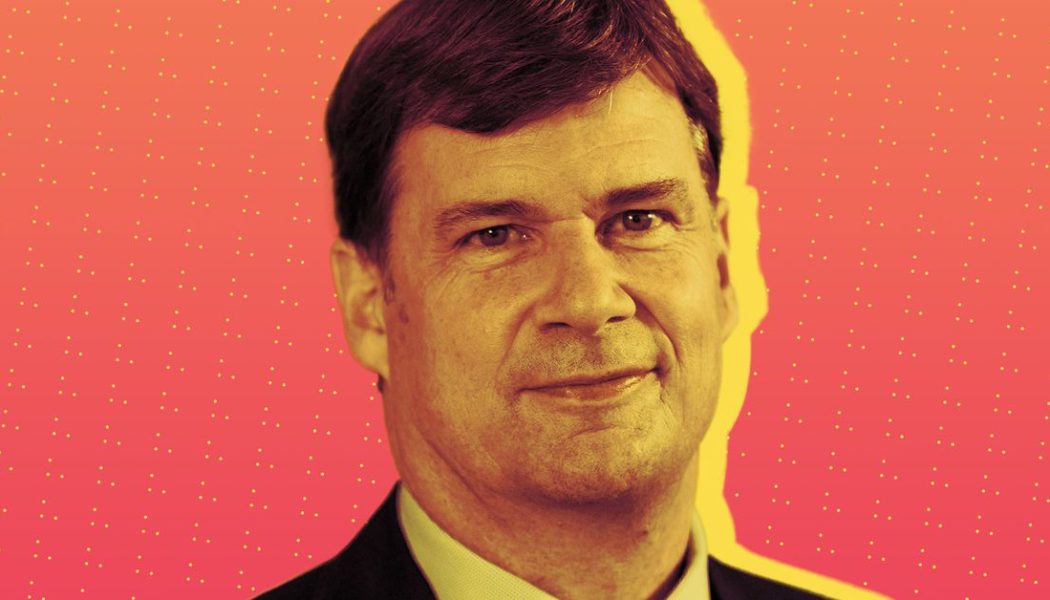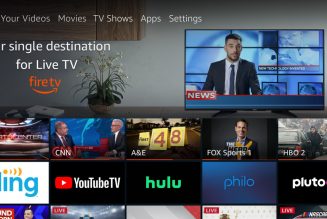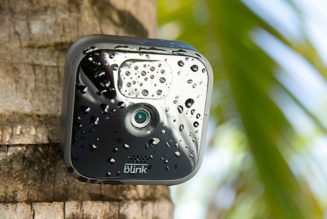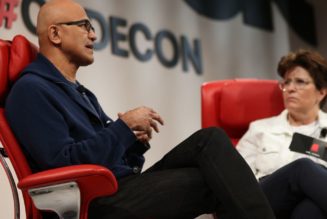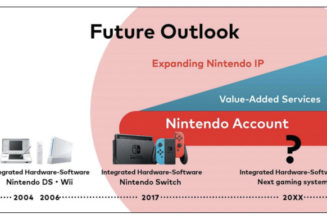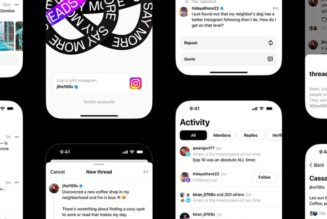
Ford just announced the new F-150 Lightning, the company’s first all-electric pickup truck, and the second vehicle in its major push into EVs — the first, of course, was the Mustang Mach-E.
That’s two of Ford’s most iconic brands now electrified, and CEO Jim Farley joined Decoder to talk about what it means to transition Ford into being an EV company, competing with Tesla, and how to build a charging network around the world that can support its efforts.
Ford also just announced a major deal with Google to use Android as the operating system in its cars, and I wanted to know what pushed the company in that direction — and how Jim sees our relationship to cars changing as they turn into what are fundamentally rolling computers. His answers surprised me — he hinted at one day being able to upgrade the computing systems of a car the same way you might upgrade or replace the engine, or the shocks.
We also talked about the chip shortage that’s having a particularly big impact on the car industry — Ford is cutting production by 50 percent this quarter because it can’t get enough chips. That’s because the chips in cars are made using much older technologies: the M1 chip in a new Mac or iPad Pro is made using a 5nm process, but a lot of the chips in cars are made using a 55nm or even 90nm process, and as demand has skyrocketed, the factories using that older tech just can’t keep up. Jim talked about needing to move Ford’s cars to newer, more flexible chips, and bringing some of those chip relationships in-house, just like any other computer company.
As more and more things turn into computers, the more problems across the business landscape look like the problems of the computer industry. It’s a fascinating shift.
This transcript has been lightly edited for clarity.
Let’s start with the news: you just announced the new electric F-150 Lightning, you brought back kind of a legendary Ford street truck name. It is very aggressively priced. I’m looking at the numbers: it’s just a hair under $40,000, and that’s before tax credits.
We avoided the $39,999 price. [Laughs] I don’t know how our marketing people came in, you know, at [$39,794]. And Ford still has plenty of federal tax credits available even though Mach-E is selling very well.
You know, look, it’s a watershed moment. I’ve been involved in the industry, worked for multiple brands, and I have never, ever driven a vehicle like this. We’ve been really hard at work innovating [the] 1.1 million F-series we make every year. We have a lot of scale, we can pass a lot of that benefit on to the customer, but we want to move customers to electric. We want this to be affordable and also give people a surprising product that they didn’t expect.
I want to talk about the Lightning, I want to talk about the Mustang Mach-E. But let me start with a big question: do you anticipate that, sometime in the future, Ford will only make electric cars, that you won’t make any gas or diesel vehicles at all?
I would say for retail, I could see that day.
We have to get to solid state [batteries], and a lot of things have to happen. Infrastructure would have to improve in places like South Africa and Australia. Ford is unlike a lot of our competitors, we didn’t really shrink our global footprint. So we’re still a very large company in Australia and Thailand and South Africa. I think it will take some time for those societies to move to full electric, but the only exception for us is that we’re such a dominant commercial brand. People don’t know this about Ford, but we’re 40 percent of the commercial light-duty vehicles in the US. We’re the leading brand in Europe, we are one of the leaders in China. We’re definitely a leader in the countries that I mentioned, with Ranger.
And so, those customers, a lot of them go 700 to 800 miles for their job, and so the technology would have to really evolve for those kinds of specialty commercial customers. Ironically, some of the commercial customers will flip even before the retail customers do. So, I don’t know how to handicap it, but it sure seems like we’re heading that way.
You mentioned Ford still has a lot of the federal tax credits that bring the price of EVs even lower for most people. Those do run out, they are finite. Some other carmakers have run out of them. Are you lobbying the Biden administration to extend that program to offer more tax credits?
Look, Ford was the only major car company to support the Paris accord and the California standards, when it was not popular in Washington, DC. And we absolutely think that to make this move to e-mobility, customers are very rational, they do the math. If electric vehicles are cheaper for them to own and operate, that will be one more thing that makes them more compelling. So we think it’s a pretty important initiative for the new administration. The key is going to be to balance a lot of other things beyond just moving to electric vehicles and zero emission, and that is labor in the US.
Ford is the number one producer of automobiles in the US. We have more people making cars and vehicles than anyone else, even though we’re not the largest [automaker]. And so we care deeply about our employees and them making this move as well. I think there’s some optionality that the government has on what else they want to stipulate as they look to support this e-mobility move, and being the biggest producer, we’ll have, or at least [get] the chance to have, an open dialogue.
But we’re very optimistic about the new administration and their priorities.
You’re suggesting that maybe you’d get a bigger tax credit if you bought an American EV versus a foreign EV?
Could be. It could be an affordable price. There’s a lot of ways for it to happen, but if we want to move into an electric future on a large scale, it can’t be $100,000 vehicles. There’s only so many people who can afford that, you know?
We have to have an F-series that starts [at no] more than 40 grand, and we have to make sure that these kinds of incentives are oriented towards more affordable price points. So, I just think there’s a lot of optionality there on how support could come to fruition, and I think the administration has some decisions to make, as they should.
Let’s talk about the Lightning. It’s cool, it’s obviously a bold product for Ford. You’ve started your big consumer EV push with iconic Ford nameplates: you did the Mustang Mach-E, and now you’re doing the F-150. It seems like with the Mach-E you’re attracting mostly new customers, that’s what I’ve been reading.
Are you anticipating that with the Lightning you’re going to get mostly new truck owners, or are you going to convert the huge base of existing truck owners?
I think it’s going to be a mixture of both.
We don’t know yet, but it was interesting, we did a survey recently and asked customers who were intending to buy a pickup truck: if you were going to buy an electric pickup truck, who would you buy it from? Who would you expect to do a good job to come to the market? Ford was by far the most preferred brand. Unlike sedans, where Tesla was a preferred brand. We were way above Tesla [in trucks], because of our history, and we know this customer.
I drove the latest prototype last week with Bill Ford, and I have to tell you — I’ve been involved, I’ve been a big sponsor of this project, [and] I was totally blown away. It’s faster than a Raptor, 770 foot-pounds of torque, zero to 60 in 4 seconds. The batteries are low, the center of gravity is low, it’s got a new independent rear suspension and standard four-wheel drive.
So the whole driving experience is totally different than a full-size pickup truck. It’s fast, it’s planted, it’s quiet. It’s like, what is going on with this thing? And then you have the whole frunk, four days of power for your home, it’s a digital product as well. I think people are going to be surprised that the innovation is far beyond the batteries and the motors.
Let’s talk about that frunk. I am fascinated by this front trunk in the new F-150 Lightning. It’s obviously a big space, right? It’s designed to hold big engines in the standard trucks, the V8s, the diesels. So you get all this space back. You can get two carry-on suitcases and a standard suitcase in there. It has four power outlets.
There’s a part of me that says that’s really cool and fun, and there’s a part of me that says it still looks like a gas-powered truck. That frunk is a result of taking out a gas engine and putting in a different kind of drivetrain. Did you ever stop and think, hold up, we could just reinvent what this truck looks like entirely? Or is there a value to the classic pickup truck shape?
Totally. We totally went through that process, actually. And when we did research with customers — we’re Ford, [we make] 1.1 million of these pickup trucks every year — they [said] look, can you bring the price down with your scale? Absolutely. So we can reuse suspension components, seats, all that kind of stuff. That scale helps to bring the price down. The second thing [we heard is], “I don’t want this to be a spaceship. I want it to be a pickup truck. I want it to act like a pickup truck, look like a pickup truck. I just want it to be different.”
I think for the frunk, the thing that you can’t read on a press release that blows me away is that with your phone or with a [key] fob, you press a button and the entire front of the vehicle lifts. It’s like this huge thing opens up and there’s this big space. And we heard a lot of people want their tools, they want their mountain bikes, they want their luggage, not in the back, in the front, lockable. It’s safe, and it’s powered. You just press a button, and it opens. It’s totally cool. It’s like your rear latch on an SUV, but this is the whole front of the truck lifts up.
There’s something about it. I feel like I need to see it to fully understand.
It’s kind of a game-changer, but I think your intuition is spot on.
You brought up the idea of customers not wanting a spaceship —obviously what you’re talking about there is the Cybertruck, right? Tesla did something very bold with the Cybertruck, it is a triangle on wheels. It looks absolutely nuts. Some people are very taken with it.
It kind of feels like with the Mach-E, you entered a little bit of Tesla’s territory, sedans — you brought it up yourself. And with the Cybertruck they’re trying to bite a little bit of yours. How is that competition going?
It’s all good. It’s all good for the customer.
That Mach-E and the Tesla Y, they are different customers. 70-plus percent of our customers for Mach-E — and we’re completely sold out — are new to Ford. It’s all good. That’s good for everyone. We’ll be in a competition of who does the most OTAs [over-the-air updates] that matter the most for customers.
And on pickup trucks, all I’ll say is there are lots of flavors of soda, but there’s only one Coke, and there’ll be lots of electric pickup trucks; there’s only one F-150.
Do you ever think about just wilding out on Twitter to compete with Elon directly?
Look, I have to tell you that I have nothing but respect for Tesla.
It was one of the most magical things that happened in our industry, to see a company so single-minded, so focused on simplicity and really reinventing the customer experience. We’ve had some moments on Twitter actually around BlueCruise.
Ford’s a customer company. We’ve been in business for 118 years because we’re focused on customers, especially in these kind of iconic spaces like Mustang or Bronco or F-150. I admire companies that are like us who are focused on customers. And I think they’ve done a great job. It’s just pickup truck customers are a little bit different.
One of Tesla’s big advantages is obviously their Supercharger network. I drove a Mach-E for a week or so a couple of months ago. The Verge reviewed it. I read a lot of the other reviews. They all kind of matched my experience: it’s a great car, one of the best EVs you can buy, and the charging situation is a little spottier than Tesla’s charging situation. Maybe a lot spottier.
You put out an F-150, those are work vehicles, people drive them a long time, long distances, and they run them all day. Charging is going to be an even bigger conversation around a vehicle like the F-150.
How do you bring up the charging network to compete with what Tesla has done?
It’s a really good point. I think we have more outlets, more than 60,000. But like you said, to find an outlet that’s not being used, that’s not broken, that’s convenient for where you need, that’s really the challenge.
It’s not the number, although we have an amazing number, I think more than anyone. It’s really the practicality of the reality of charging, as you said, day in and day out. I think what’s really different at Ford, what we’re bringing to the charging network is [that] we’re focused on commercial customers with this Lightning.
We’re going to have a retail one, and we’re going to have a Lightning that’s focused on commercial customers. It will be white, it’ll be very basic specs, and it’s going to be for work customers.
Work customers are totally different than electric retail. They don’t overbuy on the battery, [and] they have repeatable duty cycles. So they basically drive the same route every day, they know exactly how many miles it is, and they do depot charging. They don’t do charging on the road. If you’re a plumber, or electrician, you’ve got five vehicles, you charge at your business, and what we’re going to bring is a charging solution that’s very unique for the commercial customer.
Now on the retail side, we put [in] a ton of technology to make the charging of these very large batteries very unique for this truck, for the retail customer. And so I will be very interested to see how we compete with others on the charging experience, because we put a lot of extra content to allow for DC fast charging, to go faster on this than what we think the competition is going to do.
In addition, we have bi-directional charging, which is also totally new. We’ll be able to send electrons back to your house. You can sell them to the grid, and we have a special solution for retail customers who want to do that, and we put it standard in the truck. So that’s going to be a bit of a difference than Mach-E, because the charging hardware on the F-150 is different than the Mach-E.
Charging networks lead to the big question of standardization.
When you drive a Mach-E around, [and] you open the charging map, Ford looks like it has a lot of charging stations, but they’re not yours, right? The software is sort of collating a bunch of partnerships with other companies, other carmakers, and see all the charging stations around. But sometimes they’re incompatible, sometimes they don’t all charge at the same rates. You’ve got a Lightning, you’ve got a Mach-E, they use different charging technology.
If I was talking to you like a standard tech company executive, I’d ask, what’s the industry standard? How are you going to adopt it? How are you going to enforce it? How do I know that my USB-C cable plugs into computers all the same way? It feels like with charging you’ve got the exact same problem, but on a massive scale.
It’s a big deal, and you could see why it’s such a big focus for the new administration in their infrastructure investment. I think there is a lot of work to do.
I think we’ve done a very good job with what’s out there at Ford. I have no hesitation whether a Mach-E customer [can live] life with a Mach-E every day. I don’t see any risk at all in the charging experience. But there is a lot of improvement that we can make. I totally agree.
I will say, though, that Ford has the opportunity on the commercial side to do what Tesla’s done on the retail side, because we’re 40 percent of that industry, and we absolutely intend for the charging experience for our commercial customers to be a Ford experience that’s going to be unique. And we know these customers very well, and they have very different charging experiences and requirements. So I would just encourage us both, when we think about charging, we should think about not just retail — we should also think about the commercial vehicles, because it’s quite different and it’s starting from scratch.
The Lightning is coming out, you’re widening the aperture of what an electric car can do. The Mustang Mach-E was the first of your consumer push. It seems like it’s been very successful; you’re saying it’s sold out. What have you learned now that it’s launched and people are buying it?
I think we’ve learned two things. You touched on one. Charging, we have continuous work to do, probably for the rest of my career, on making the charging experience better and better and better. That’s one thing.
The second thing we’ve learned is, boy, the data off the vehicle is just invaluable. We are constantly shocked every day of how many quality issues we can catch and improve in an OTA [over-the-air update]. We did our first high-volume OTA for the F-150 and the Mach-E, and we solved a bunch of problems, like battery drains, that in the past would have taken a safety recall. So we’re really saving money, more than we thought, in improving quality. But it takes a lot to do that all, because the datasets off the vehicles every moment are so big. There’s such big datasets. And you need AI to analyze what’s a problem, and what’s just a signal.
The third thing I would say is we’re now realizing how important it is to have a dedicated group — far after job one — to make that customer OTA feature set better and better and better. So we get 10 more miles every year out of the range, we get four or five marquee customer experiences like BlueCruise that we OTA. For a car company [that was] focused on, “we’ll sell you a car and we’ll see you in four years,” [that requires] being always on for the customer every day. It is a complete game-changer where we have to be software-first.
We’ve been transitioning already, but to do it at scale — not at hundreds of thousands like Tesla’s doing, but 6 million a year like Ford does — it’s a really big lift. So I think that’s what we’re learning from Mach-E. It’s very exciting, it’s a huge change. We are hiring software leaders for those OTA features as fast as we can and we’re learning a lot about the potential. But I would say so far, it’s all good.
You just signed a deal with Google, Android is going to power Sync in the future. How long should people expect Ford to support the computers in their cars the way that I expect Apple to support my iPhone for eight years or 10 years?
This is such an important question. It’s actually the first time I’ve ever been asked this question.
I would tell you that we have to go through a kind of game-changing mentality of simplifying our technology stack so we can support all the software releases for all this complexity. This is probably one of the key areas that I spend the most time on.
Right now we have updatable vehicles. With the exception of the body control module, most modules now — some people had the entertainment modules — we can do pretty much the whole car, like powertrain, with the exception of body control.
We’re going to a fully networked vehicle soon. Like you said, a computer on wheels.
So how much software resources do we put on vehicles that have the previous updatable? We’re up to millions of connective vehicles now. I think at Ford we’re a trusted brand, frankly, more than a lot of technology companies, if you look at the surveys. We’re going to have to commit to the resources to support these vehicles that we’re launching now for decades to come.
The real lift is going to be, how do we simplify going forward so that we only have certain hardware and embedded software solutions, complexities, so that we don’t go crazy with our software resources?
It seems like the challenge is — I might get a new phone every two years, but it’s worthwhile for the phone makers to update the operating system on my phone because they can still monetize it over time. Epic v. Apple is at trial right now for who gets to monetize the phone and how; that pays for a lot of software maintenance, a lot of care for a piece of hardware that I might swap at a pretty high rate.
I have a car for way longer than a phone. It sits in the driveway or the garage for years and years and years. You don’t have that secondary monetization of a car. You’re collecting some data, but I don’t want you to monetize my data directly. So how do you support the cost of software updates for a decade against a car that you’ve only gotten to monetize once?
I want to challenge your thinking a little bit, because I absolutely see an upgradable car, a physically upgradable car. We have to get our heads around that as an industry.
You take a Crown Victoria taxi, that thing probably got upgraded on its way to 300,000 miles like four or five times. The springs, the suspension, the brakes. We have to get our heads around updating communication modules and other things in the vehicle, because we want to take advantage of the pace of change in consumer electronics.
I would say you can expect, in a fully networked vehicle, the software using Linux, and ethernet, and Android, is going to be very similar to your phone. There’ll be software updates for your embedded software system just like there is with your phone, and it’s going to make your car, your vehicle, a lot better.
And unlike your phone where you may get a new one two or three years later, we’ll have lots of used cars. A lot of our commercial customers used to buy because the emission standards changed. They had to buy a Euro 6 or a new F-150 Super Duty. With electric, that’s out the window, zero emissions. So I could easily see customers owning these vehicles, multiple customers, [for] 30 years. It could be like a 737 fuselage, where it gets upgraded. I think that’s absolutely on the table.
That connects to a big topic that I want to make sure we talk about: there is a chip shortage right now. It’s hitting carmakers especially hard. Ford is cutting production by up to 50 percent this quarter because of the chip shortage. I saw you were on CNBC today, and you said you’re redesigning some components to use more accessible chips.
That, to me, is code for, “We’re on a bunch of old process nodes for the chips in the car right now, 55 nanometers and above, which is really old tech, and we have to get to where the industry is able to produce supply.”
But that means you’re going to start using really modern chips. Are you anticipating that you’re going to add functionality or be able to take bigger leaps in what cars can do because you’re going to start using these more modern — and in some cases more efficient and more price effective — components?
There’s a couple things we’re insourcing that we never used to. We’re insourcing autonomy. We’re insourcing software. We used to give that to our suppliers. The 70 modules to control an F-150, five years ago, all the software was owned by someone else. So we’re insourcing all that. And we’re insourcing cell production and knowhow inside the company.
One of the things that’s really obvious to us right now is the SOC [system-on-chip] design. Not only do we have to move to 22nm or smaller, more advanced [semiconductors], more importantly, we have to be in a position to know inside the company what to choose and customize off the shelf computes to work for us, because we’re going to be doing a lot of AI processing.
All the video we’re ingesting, that has to be AI processed on-board to make decisions, let’s say, on partial autonomy. We are going to have to have real expertise in the company on silicon and design. It’ll be a transition. We’re going to that now with battery cells now, and we absolutely have to think about our supply chain similarly. Buffer stocks, direct deals with foundries. We can’t just run a just-in-time manufacturing system and have exposures like we do today. It’s just too dangerous.
There’s a big push from a number of chip makers and foundries to do the manufacturing in the United States, to get various incentives from the administration to support that investment. All of that still looks like 10 years out. How do you solve the chip shortage today? Do you just wait it out, or are there steps you can take?
Well, there’s certainly things we can do. For single-source content, like the Renesas Naka facility that had a fire, those single-sourced chips, we can run some buffer stocks. Which is not ideal. It’s kind of a waste, but it’s better than running out of what we have.
The other thing we can do is to give the foundries more confidence in future production by going direct with them. So on behalf of our supply base, actually going and contracting purchases. I think boots on the ground in places like Taiwan and China and Asia are going to be more important for us.
I think there’s certainly things we can do to make it better. We are starting to see some confidence in the second half of this year, but when I talk to my colleagues at Cisco, and Dell, and other companies, they run the supply chain totally different than automotive. And it’s about time for us to catch up.
We’ve talked about a lot of multivariate problems to solve. Moving both retail and commercial to EVs, supply chains, re-architecting the company to be more of a software company.
I ask every executive this question. You’re the CEO of Ford, one of the most iconic American companies. What is your decision-making framework? How do you make these decisions?
We have a 10-point plan. It’s very simple, but hard to execute.
First thing is, we have to turn around automotive operations. You know, we’ve been in markets and products that have never been profitable and don’t have a sustainable view to profitability. We have to simplify that and really get into those iconic vehicles that we’re really good at naturally, like the F-series electric. So turning around automotive is really essential for us because it funds all the next things I’m going to talk about.
The second thing we have to do is modernize the company. And that means really not just electric vehicles. [It’s] much more important to go to a digital product, which you and I have been talking about. Investing in advanced electric architectures with embedded software systems and a flexible software system that can adapt to new sensors, using the data off the vehicle to make the quality loop better, and giving the customer better functionality over time with the vehicle. That’s modernizing Ford.
We have to go really deep on commercial. We are the dominant player globally. Light commercial vehicles, it’s a great business, it’s a very different kind of customer, we do it naturally, and we need to vertically integrate the services. What does that mean? That means in the past we had other people do services [like] fleet management, telematics, financing for small businesses for their chargers, charging itself. We need to vertically integrate. And that means [going] into physical services and digital services for commercial customers.
And the last thing we need to do is disrupt ourselves. Now that’s really hard because Henry Ford kind of democratized transportation with the Model T, and here we are. And the way we disrupt ourselves is to go to a per-mile or per-day type of model where people don’t own, but they rent. That’s a big disruption to our business model. I’m not going to get into specifics. It doesn’t have to be all autonomous. We’ve been in the Spin business, micro mobility’s really interesting. We’ve learned a ton [from] that. It’s really informed our next generation of our thinking in this per-mile business.
That’s really what the company’s going to look like. Three different kinds of businesses, a disrupted per-mile rental model, a commercial services company, and a modernized Ford. It’s a full-time job. We’re going to be busy for many years to come, but boy, the F-150 electric and the Mach-E are good first examples.
You mentioned iconic brands there. I want to ask this question, and I want you to walk me through it using that decision-making framework.
I read every piece about the Mach-E that was written. I’m obsessed with this thing. And [there’s a] really big split in the decision to make that project a Mustang. In about half the articles, the [Mustang] team takes credit for it. They say, “We decided it was going be a Mustang.” And the other half of the articles, I hear it was your decision.
So, A, tell me which one’s right, and B, walk me through that decision to say, “Okay, we’re going pivot the EV product into one of our bigger, more famous brands.”
It is kind of an interesting story. It’s one of the things I’ve learned in this business, of excellence in products, is when you have something like a Mustang and you tell the organization, “This is going to be a Mustang,” everything changes.
Like, all the doors open, you can hear the celestial humming, and people get really, deadly serious about a perfect product. And so I knew that in the sea of ubiquitous, generic, electric commodity vehicles, that Ford could really be different and more emotional — let’s say that Detroit swagger — with a Mustang-themed electric car. That means it would have to sound different, it would have to go like heck, it would have to handle well. And yes, we could add modern technology to it, not just a bed, but the UX experience inside the vehicle. But you have to bring your A-game and you have to bring what makes you different as a company.
So when the organization got focused on making it a Mustang, everything changed. Literally, everything changed. We went from a pretty generic execution informed by the wind [tunnel], to a complete vehicle that only Ford could do. I saw it happen.
I could see it happen on Bronco, I could see it happen on a lot of our vehicles: when you get the team excited about one of these iconic vehicles, the responsibility and the accountability in the organization changes. That’s why it was a game-changer for us.
I’m not going to get into the who did what — I’m the last person to ask who did what to whom and all that stuff. All I care about is a great product. And I know the truth in life, which is if you want great products, stick to what you’re really good at. We’re really good at Mustangs, we’re really good at F-series.
One of the things that I noticed about the Mustang when I had it, is it has barely any Ford logos on it. The Bronco has barely any Ford logos on it. F-150 Lightning is a new brand. You’re very focused on these sub-brands of cars. How does that relate to your positioning Ford?
Our strategy is very simple. We are going to double down on our iconic nameplates and we’re going to build a family of vehicles. And there’s going to be diversity in those icons. They come naturally, we have high intimacy with the customer. Being with F-150 customers to us is like having a barbecue. They’re our next-door neighbors. We know them that well.
The Homer had a donut maker and a beer dispenser. If you ask people what they want, you get a Homer. But if you know the customers really well, you can surprise them with 12 kilowatts of power to power their home. They won’t expect that, they won’t tell you they need that in a focus group. But if you know them well enough, you know they’ll like it.
One of the big features of the new F-150, the Lightning included, is BlueCruise, which is a fairly advanced driver-assist system. It can get you down a bunch of highways. In order to execute that, you need a bunch of mapping software, you need an interface. You’ve got to get away from — every car review video I watch, they look at the center screen and they’re like, “it has CarPlay and Android Auto,” and that’s the end of talking about it.
But if you’re going to do self-driving, you gotta retake that screen. What is that investment like and what does Google bring to the table that you need there?
It’s such an important point, because I think this area of our business is going to change more than people think. First of all, the Apple ecosystem, I’m sure, is going to get really good. And so, for [all the] Android customers who want a really good solution, we also want to have the best Apple CarPlay experience too.
Look, our industry is filled with people spending. It doesn’t differentiate us. Do I want my team spending hundreds of millions of dollars building a navigation system, compared to what I get on my phone? The answer is, “only if it’s better.” An Android or a Google Automotive Services gives us a chance to really have a stable platform by a really good tech company who knows their customers really well, for content delivery and navigation, and great maps. And we can get my team focused on what’s going to differentiate us on top of that platform, instead of spending money on empty calories doing stuff that doesn’t really matter. And I think that’s our philosophy now.
It’s a little bit tricky, because it feels like the brand is starting to be giving up in places. But, you know, at the end of the day, our digital lives are what they are, and Ford has to get real with that, and I want our team working on stuff that’s going to differentiate us. Iconic software experiences, not empty calories that, like a CD player or eight-track player, really just won’t matter anymore.
I buy a Mustang Mach-E today. Next year, you come out with a version that runs Android. You’ve already talked about upgradable cars. Will I be able to upgrade my current Sync 4, Sync 4A systems to the next version of Sync that runs on Android?
I think, generally speaking, the approach we want to take… it’s going be a lot simpler when we go to fully networked vehicles.
But the approach we want to make is that you’re always going to have that upgradability. There will be some transition, where the [system] on the vehicle is just not capable yet, or the embedded software is not capable yet to fully change the customer experience. But over time, that’s absolutely where we’re going. Android Auto is especially powerful in that regard as well [as] Google Automotive Services.
But Apple is going be out there doing similar things, and we’re going to do something maybe unique for Ford on commercial, because we want to insource that digital experience, because there’s no one out there that can do it better than us. So I would say philosophically, you can expect a yes, but it depends on what you buy and what you own, because there’s a transition period.
I think you know I own a F-150 Raptor Gen 2. You’re coming up on the release of the third generation. Every Raptor owner in the forums wants to know: what is the horsepower and torque number of the Gen 3 Raptor?
[Laughs] You put me on the spot. You had to wait for this question at the end. Okay. So, it’s going to be a lot.
Is it more than the one I have now?
It’s going to be a lot. I will tell you that, by the way, the F-150 electric will be faster.
But we’re not going to just have one Raptor. So, I have a couple choices of different numbers to give you. The reality is we’re finishing the engineering and we have to certify the vehicle, and I can’t give you a horsepower or torque number until we certify with the US government, because it could change. And it will change. But we definitely have a target and the new Raptor is going be all that, and it won’t be the only Raptor. Because Raptor is an iconic nameplate, too.
Am I going get an electric Raptor? That was a big shrug.
I tried. You have to give me credit for trying.
You’re going for it, you’re going for it. My PR folks are warning me, “Stay within the lanes, Jim.” I’m really excited about the Raptor. It’s a great brand. We did Raptor over 10 years ago and, you know, coming for Toyota desert-racing trucks was a big deal for us.
I knew this was going be a thing, or could be a thing, because the suspension is so compliant, it’s so fun to drive, but it’s also so comfortable and it looks so awesome, and it’s so capable. And the high-speed part would be something new for the industry and I think it’s great that we have customers like you that the vehicle resonated with. And we’re not going to stop. We have lots of vehicles, but Raptor is very special for us, like the Ford GT. We’re only going do it when it meets its requirement. We’re not going to democratize it. It’s always going to be something special at Ford.
So I can’t wait to show you the new one. I honestly can’t give you the stats because we just haven’t finished it.
I had to try. All right. Jim, thank you so much for being on Decoder. This was great.
Really enjoyed the time. I love the orientation of your questions and I wish I had more chances to talk to tech experts like you, frankly.
